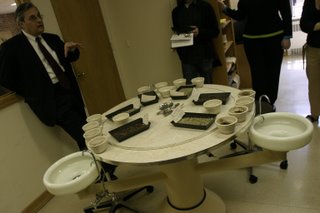 Image from article link below.
Image from article link below. Is it true you've made it once you've been misunderstood? Until now, my career in print consisted of an uncredited review in a resort-town tabloid and a photo of a slab of my hairdo from a Chelsea boys' life mag. Now, my name is appearing in print- well, online print- but as it's part of a wire service, someone may print it somewhere. And my name's been misspelled, so I can try to tell myself it's a different person whose quotes the writer contextualized so as to make me sound like a crotchsnagging nosebag.
The Columbia News Service article.
Find the early quote that sounds most like the snobby Comics guy from The Simpsons remarking on Flash vs. Aquaman, and that's me. In the wide photo of the table above, I'm the second undistinguished body from the right, with a green hem on my sweater. The suit-and-tied guy on the left goes unmentioned and is probably the premier expert on coffee in the U.S.
I do not count myself among “coffee crazies”--consumers who treat $20-a-pound Kona beans like a 1995 Bordeaux, and spend hours each day [emphasis mine] talking about, researching and savoring flavors. I also don't treat my "addiction like an art form" since I don't drink enough caffeinated beverages each day to even get a headache if I can't get a fix. Moderation is possible, but perhaps works against journalistic purposes. Further, I think she could have come up with a better Bordeaux year for reference than the '95, and only a couple coffees are aged. Coffee's about freshness. Whatever.
Now, my real explanation and defense, my perception of the scene she described elsewise. You may feel free to ignore it, but I'll feel better.
Once upon a time there was this stringer who wanted to write a story about coffee and dieting. And through the wonders of surfing, she found Fortune Elkins' blog- who was my own intense welcomer to the world of specialty coffee- who in turn convinced the young journo that there was far more interesting and compelling coffee stuff to cover. Quite true.
Following the editor's agreement, Fortune planned a professional cupping experience where the journalist and her photographer could meet some acknowledged experts in the field, including fifth-generation coffee man Don Schoenholt of Gillies, the nation's oldest coffee merchant, and Mary Pettit, Executive Vice President of the Columbian Coffee Federation, who volunteered her NYC office and cupping lab for the event. Despite the article, Mary was the one actually roasting the coffee and discussing the process in detail since she is both a certified cupper and one of the first women cuppers allowed on the NY Coffee Exchange. It is a tremendous pity that she wasn't mentioned and quoted. Nor was Schoenholt who exudes classic New York attitude and is a great spinner of coffee history and lore. Insult to injury means your foolish poster was quoted and named, despite my near silence throughout the event while listening and taking notes from the experts' discourse.
In coffee, cupping represents something different than just tasting like you might do for friends over brunch. Cupping is a professional, highly-controlled tasting of multiple samples from a single batch and is used to certify coffee origins and quality. It has a purpose in grading coffee and legally arbitrating differences about whether a contract has been adequately fulfilled. I and a couple of other amateurs were invited along to provide the low end of the curve in knowledge, and we added our enthusiasm even if our ignorance significantly diluted the expertise in the room. So, inside a commercial organization's lab (nothing like what you'd do at home unless you have a $5,000 batch roaster and spectrometer on your counter- need I mention the dental spitoons?), we were cupping a few different award-winning coffees from recent Cup of Excellence judgings. This is NOT what your friendly neighborhood coffee-hounds are doing regularly while trading sips of double-shot espressos.
It was a fascinating experience, especially with such pros to inform the process, but it isn't something you'd do at home any more than buying the technology to count the threads in your own sheets. As careful consumers, we can benefit from learning how thread count, origin, and type affect the final product, and we might invite friends to share something we bought that's terrific, but we're not handling the back office procedures of verifying the staple of the raw cotton or the actual count ourselves. We're using better labeling as our guides. So too, coffee.
However, the journo didn't seem to understand that, neither did she seem to understand that the only coffees on the table were champions. People might individually prefer one over another, but they were all exceptional examples of their style. Anyway, because I perceived by her questions that she was serially misunderstanding the role of cupping (no, amateurs won't be doing it), and that there weren't any losers on the table (no, it's not a coffee cage match), I said the bit about fancy cars that she did understand and that makes me sound like a complete shmendrick.
She also reports Fortune, a pursuer of transendence in baked goods as well as fine chocolate and a passionate yogini to boot, finds her greatest relaxation invading a commercial lab to cup coffee she's not technically qualified to judge. Ah, well. Here, I must paraphrase the divine Mary Pettit whose devotion to the cause of coffee exceeds her vanity, as mine unfortunately does not. After reading the article, she remarked along the lines of: If it makes people more aware of specialty coffee, that's great.
Someday, I hope to be enlightened, too. Until then, I's OBSESSIVE and CRAZY!

No comments:
Post a Comment